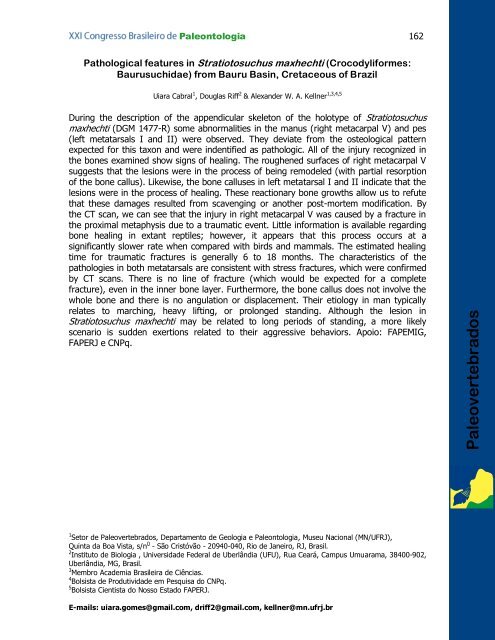Livro de Resumos - Dinossauros do Maranhão
Livro de Resumos - Dinossauros do Maranhão
Livro de Resumos - Dinossauros do Maranhão
Create successful ePaper yourself
Turn your PDF publications into a flip-book with our unique Google optimized e-Paper software.
Paleontologia 162<br />
Pathological features in Stratiotosuchus maxhechti (Crocodyliformes:<br />
Baurusuchidae) from Bauru Basin, Cretaceous of Brazil<br />
1 Setor <strong>de</strong> Paleovertebra<strong>do</strong>s, Departamento <strong>de</strong> Geologia e Paleontologia, Museu Nacional (MN/UFRJ),<br />
Quinta da Boa Vista, s/n 0 - São Cristóvão - 20940-040, Rio <strong>de</strong> Janeiro, RJ, Brasil.<br />
2 Instituto <strong>de</strong> Biologia , Universida<strong>de</strong> Fe<strong>de</strong>ral <strong>de</strong> Uberlândia (UFU), Rua Ceará, Campus Umuarama, 38400-902,<br />
Uberlândia, MG, Brasil.<br />
3 Membro Aca<strong>de</strong>mia Brasileira <strong>de</strong> Ciências.<br />
4 Bolsista <strong>de</strong> Produtivida<strong>de</strong> em Pesquisa <strong>do</strong> CNPq.<br />
5 Bolsista Cientista <strong>do</strong> Nosso Esta<strong>do</strong> FAPERJ.<br />
Uiara Cabral 1 , Douglas Riff 2 & Alexan<strong>de</strong>r W. A. Kellner 1,3,4,5<br />
During the <strong>de</strong>scription of the appendicular skeleton of the holotype of Stratiotosuchus<br />
maxhechti (DGM 1477-R) some abnormalities in the manus (right metacarpal V) and pes<br />
(left metatarsals I and II) were observed. They <strong>de</strong>viate from the osteological pattern<br />
expected for this taxon and were in<strong>de</strong>ntified as pathologic. All of the injury recognized in<br />
the bones examined show signs of healing. The roughened surfaces of right metacarpal V<br />
suggests that the lesions were in the process of being remo<strong>de</strong>led (with partial resorption<br />
of the bone callus). Likewise, the bone calluses in left metatarsal I and II indicate that the<br />
lesions were in the process of healing. These reactionary bone growths allow us to refute<br />
that these damages resulted from scavenging or another post-mortem modification. By<br />
the CT scan, we can see that the injury in right metacarpal V was caused by a fracture in<br />
the proximal metaphysis due to a traumatic event. Little information is available regarding<br />
bone healing in extant reptiles; however, it appears that this process occurs at a<br />
significantly slower rate when compared with birds and mammals. The estimated healing<br />
time for traumatic fractures is generally 6 to 18 months. The characteristics of the<br />
pathologies in both metatarsals are consistent with stress fractures, which were confirmed<br />
by CT scans. There is no line of fracture (which would be expected for a complete<br />
fracture), even in the inner bone layer. Furthermore, the bone callus <strong>do</strong>es not involve the<br />
whole bone and there is no angulation or displacement. Their etiology in man typically<br />
relates to marching, heavy lifting, or prolonged standing. Although the lesion in<br />
Stratiotosuchus maxhechti may be related to long periods of standing, a more likely<br />
scenario is sud<strong>de</strong>n exertions related to their aggressive behaviors. Apoio: FAPEMIG,<br />
FAPERJ e CNPq.<br />
E-mails: uiara.gomes@gmail.com, driff2@gmail.com, kellner@mn.ufrj.br<br />
Paleovertebra<strong>do</strong>s


